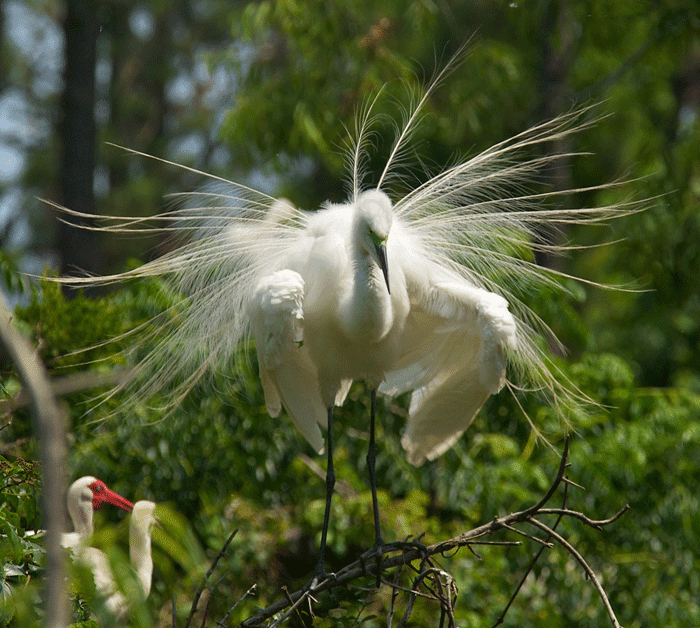Up until now I haven’t been able to write much about Pinckney Island. Twice I’ve sat at the computer to record a few thoughts, but nothing comes out. Actually, too much comes out, and it gets all jumbled and clogged in the process, and I don’t like that. It makes me feel antsy and almost panicky, so tonight I took a few breaths, slowed down and realized I’d just have to wait until the words decided they were ready to seep out of my brain, not rushing or forcing them, just going with the flow and seeing where it led.
The beginning…
Each trip to Pinckney Island National Wildlife Refuge starts with happy anticipation and excitement as you drive down the long, narrow road that leads to the parking lot. Flanked by tidal marsh, the grasses and reeds on either side of the road usually give you your first glimpses of Ibises and other water birds. Several times I pulled over and got out of the car because something interesting caught my eye. One time six Snowy Egrets were playing in a mudflat, tossing their plumes around and chasing after a swarm of little fiddler crabs, obviously eating their fill. When you see something like that, something so subtle and unique that it takes your breath away, happiness flows right through you. At that point I remember thinking the road should be called “Happiness Way," because that's how you feel when you're on it, and I’m sure any other bird lover who drives on it would agree.
After you park, don’t rush out. You can spend a decent amount of time birding in the surrounding woodland. I saw Painted Buntings, a male and female Red-headed Woodpecker, Downies, Great-crested Flycatchers (
and their nesting cavity), a Yellow-throated Warbler, and many other birds, but I’m going to save those stories for another post. A little later, an older gentleman with binocs around his neck (
the universal signal for “Hey, it’s okay I’m a birder!”) came up and asked me if I’d been to Ibis Pond yet. When I told him it was my first time to the park, and I didn’t know where Ibis Pond was, he said, “follow the gravel path for about a half mile and be amazed.” So that’s what I did.
The gravel path to Ibis Pond is a fairly wide land bridge. It can accommodate a car, but only maintenance vehicles are allowed. Regular folk like you and me have to walk or ride bikes. The walk seemed long at first (
only because I had a torn Plantar Fascia ligament and had no idea where I was going), but I loved it anyway. Patches of woodland and salt marsh surround the path, so you get to see many types of birds along the way, including, of course, more Painted Buntings. Two times I saw them up ahead pecking around in the gravel…three and four together at the side of the road. Hinting at what’s to come, Great Egrets, Snowy Egrets, and innumerable Ibises fly back and forth over your head a lot—graceful, beautiful, and oblivious to anyone below.
When I reached a grassy area, I still didn’t know where I was, so I just stood and looked around. That fabulous southern sun was soaking into my skin…warm and wonderful, and a cooling ocean breeze was sweeping through the trees and grasses. We just don’t get breezes like that in Cincinnati on hot, humid days, and it really hit home that I was on vacation…at the ocean…in the south…, but before I could finish that thought, a Black-Crowned Night-Heron flew by me and landed in a tree about 25 feet away. I couldn’t believe it. I rushed over holding my breath, still not believing my luck, and trying to be quiet (
and cool, but that was probably not possible because I’m sure I looked like a dork trying to set up my camera and cover ground at the same time). It took me a few seconds to spot him, but there he was…in a tree…about 10 feet above me. I could see his blood-red eye so clearly through the lens I stopped snapping and just watched. Eventually he turned his head and looked directly at me. Then he looked away with indifference, slowly walking down a branch. Finally I lowered my camera and noticed there were other Black-Crowned Night-Herons scattered in the tree, all resting in the heat of the morning, roosting, and sleeping.


I see you camera-lady, and I'm not impressed.

I have really long toes. All the better to climb in trees with...

Yes, I know. I have a gorgeous red eye. Go ahead, snap away...

It's morning and I'd rather be sleeping.
I'm a night owl...I mean Night-Heron.
Because I've reduced these files down so much and saved them for the Web, which reduces the file size even more, but also reduces the quality, the deep red of the eye has been lost on most of the photos. Rick suggested just cropping out an eye shot. I did, but have to say the quality is still missing, but you do get a better idea of the deep red. I need to get get a Flickr account or something like that so I can post the higher quality images. My blog loads slow enough as it is! Does anyone have any suggestions on how to maintain quality yet keep the file size small?






























































